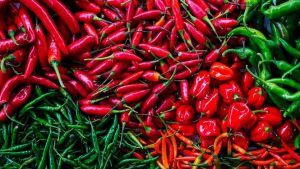 Scientific name: Capsicum annuum
Scientific name: Capsicum annuum
Usage
Non-culinary Uses of Chilli Peppers
Chilli peppers burst with free-radical scouring antioxidants. Studies show that capsaicin exhibits antiviral and antibacterial properties as well (Plant Cultures). Proven topical applications of chilli peppers include cream, gel, lotions, and patches to relieve joints and nerve pains often associated with osteoarthritis and diabetic neuropathy. In the future, capsaicin injections may replace cortisone injections (Carter, Lazar and Burch).
While capsaicin irritates, it may also have homeopathic qualities. In fact, scientists believe that capsaicin may be able deplete substance P, the neurotransmitter that alerts the central nervous system to pain.
Capsaicin has several other medical uses, including:
- Lowering blood pressure
- Lowering serum cholesterol
- Working as an anticoagulant
- Treating herpes
- Relieving stomach pain
- Treating shingles
- Ongoing studies show promise in the prevention and control of an array of conditions
- Migraine relief
Two common commercial uses of chilli pepper derivatives are pepper spray, and food and cosmetic which dyes developed from. The Chinese police also serve them to sleepy motorists to keep them awake behind wheels. There was also a time where chilli peppers were used to stop advancing soldiers.
Cayenne powder has several different uses. Gardeners use it to deter mammals and insects, and homeowners use it to repel ants, squirrels and other wildlife. Some people even add a dash of cayenne powder to their socks to keep their feet warm (PLASTER, 2019).
Country of Origin
Chillies have been grown and cultivated as early as 3500 BC. Mexicans use it to spice up their food. Chilli was brought to the rest of the world by Christopher Columbus who discovered America in 1493. Columbus had set from Spain to reach India to bring spices such as pepper back to his country (Anonymous, Chilli, 2019).
Time to harvest
Chilli plant will produce ripe fruits between 2 to 4 months after sowing. Harvest chillies as and when they ripen to encourage the plant to produce more chillies (Sanderson, n.d.).
Share with:

